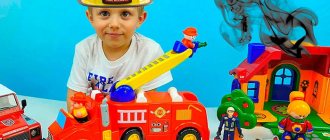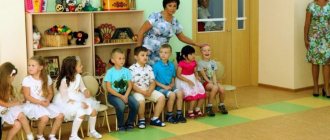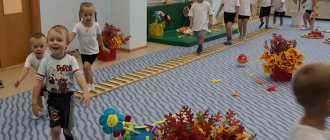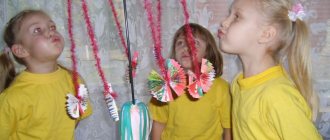According to Maria Montessori's periodization of development, the peak of activity in a variety of directions occurs in children precisely at the age of 2 to 3 years. Kids actively master speech and movement, learn to interact with a variety of objects, learn patterns and become sensitive to order, and also begin to expand their circle of acquaintances and make their first friends.
All this means that it is at this age that it is important to arrange for children all kinds of activities and games for harmonious development.
The motto of the Montessori philosophy is: “Help me do it myself.” The task of adults is to inspire children to make independent discoveries and achievements, because our little ones can do much more than it seems at first glance.
When planning Montessori activities for children 2-3 years old, you should adhere to the following rules:
- Classes should be aimed at increasing the child’s independence,
- Use different senses
- Include elements useful for the development of fine and gross motor skills,
- Take into account the interests of the child and use only at his request,
All Montessori activities should be presented to the child in advance, located in a place accessible to him (on a low shelf) and be accessible without the help of adults (however, exercises with small objects should be offered only when you have time to monitor the baby).
Montessori classes to develop a sense of order for children 2-3 years old
Such exercises help the child understand the principles by which our world exists; mainly here we work on sorting and classification.
Find a pair - Montessori classes for 2-3 years old
The principle of pair selection can be very widely used in working with children:
- Invite your child to sort his own socks and gloves.
- Print out images of animals and offer to compare the picture with existing toy models (the same can be done with your favorite cars, flowers, building models, etc.)
- Offer to find paired cards (colors, images, textures),
- Use special Montessori materials for 2 years and older
Sorting – complicated Montessori games for children from 2 years old
When the baby has mastered pairs, you can move on to a more complex option - sorting.
- Sort cards of different shades by color (you can cut pictures from magazines, scraps, colored cardboard, or you can buy a ready-made Montessori set),
- Remember Cinderella and offer to sort out different types of cereals. First, it is better to take larger grains: beans, chickpeas. Children's breakfast cereals with their cereals, pillows and rings can also be convenient,
- Sort out the box with grandma's buttons by shape, color or number of holes (you definitely have one!)
- Ask your child to put the cutlery in its place,
- Offer to clean up the kitchen and put all the cylinders and balls in one direction, and the cubes and parallelepipeds in the other,
- Rewind the salad: cucumbers to cucumbers, tomatoes to tomatoes, and so on
Establishing Montessori Sequences for a Child 3 Years and Under
- Lay out cards with simple stories and ask your child to remember the correct sequence of events.
- Use Montessori cylinders to help your child master the concepts of less-more and lower-higher,
- Learn simple self-care steps, breaking them down into steps. This way you can learn how to brush your teeth, take a shower, care for animals, and get ready for kindergarten.
Montessori classes for the development of fine motor skills for 2-3 years
Little hands still don’t obey as well as adults, but finger coordination is the key to brain development. That is why fine motor skills are given great attention in preschool pedagogy.
Simple lacing is an excellent Montessori activity for children aged 2 years and older.
- Did your parents buy new shoes? First, ask your child to sort out the lacing. Children's shoes may be too small to be familiar with laces, so older ones may help.
- You can purchase a beautiful Montessori set for mastering lacing,
- Make beads or a bracelet from cord and large wooden beads,
- Master weaving craft with your child: weave a rug from large scraps, or maybe you have enough patience for a whole bag,
Pouring water and playing with small objects - Montessori activities that delight children 2-3 years old
- Don't be afraid to encourage children to pour their own water from the jug. Yes, perhaps several glasses will end up on the floor, but after a couple of times the baby will master this task without any problems and will be able to maintain the drinking regime himself (do not forget to offer the child a rag or mop in case water spills),
- Make the most of bath time: children can spend hours fiddling around in the bathtub with molds and toys, and this activity is extremely beneficial for their development,
- Pour small cereal into a bowl, give the child a spoon or scoop and offer to pour it into another container (the width of the neck will determine the difficulty of the whole activity),
- Invite your child to sort small objects (coins, pom-poms, peas, shells or pebbles) using tweezers,
Didactic games
The games below will not only encourage the timid and cheer up the crying one, but will also calm the overly naughty child, redirect attention and help relax the angry, aggressive child.
Playing with a dog
Material. Toy dog.
Progress of the game. The teacher holds the dog in his hands and says:
Bow-wow! Who's there? This is a dog visiting us. I put the dog on the floor. Give Petya a paw, little dog! Then he approaches the child, whose name is named, with the dog and offers to take it by the paw and feed it. They bring a bowl of imaginary food, the dog “eats soup,” “barks,” and says “thank you!” to the child.
When repeating the game, the teacher calls the name of another child.
Collecting "treasures"
Material. Basket.
Progress of the game. During a walk, the teacher collects “treasures” (pebbles, pods, twigs, leaves, shells) with the child and puts them in a basket. Finds out which “treasures” arouse the greatest interest in the baby (this will suggest further ways of communication). Then he names some “treasure” and asks to take it out of the basket.
Making a collage
Material. Scraps of colored paper, greeting cards, string, pieces of foam, yarn, etc.
Progress of the game. The teacher spreads a large sheet of thick paper or cardboard on the table. Using a brush, coat a piece of foam plastic (postcard, etc.) with glue on one side and hand it to the child to stick it on the paper. Allows the child to choose the items he would like to stick on. After carefully observing the actions of an adult, the child will be able to apply the glue himself. The completed collage can be hung in a prominent place for everyone to admire.
(The game helps develop creative skills.)
Caught a fish
Material. Cardboard box, metal bottle caps (“fish”), magnet, stick and rope (for a fishing rod).
Progress of the game. Several metal bottle caps, preferably of different colors, are placed in a cardboard box. A stick is tied to one end of the rope (or ribbon), and a magnet bar is tied to the other. The teacher shows the child how to fish “fish” out of the box by attracting metal plugs with a magnet. If the corks are different colors, then the baby can be asked to pull out, for example, a red fish.
After all the plugs have been removed, the adult counts them (“That’s how many fish we caught!”), and the game starts over.
(The game helps develop coordination of movements.)
Let's ride a horse
Material. Rocking horse (if there is no horse, you can sit the child on your lap).
Progress of the game. The teacher puts the child on a rocking horse and says: “Masha is riding a horse, (says in a quiet voice) no-no.” The child repeats quietly: “No-no.” Adult: “To make the horse run faster, tell it loudly: “No-no, run, little horse!” (Swings the child more strongly.) The child repeats the phrase together with the teacher, then independently. The adult ensures that the child pronounces the sound “n” drawn out, and the entire sound combination loudly and clearly.
(The game develops speech activity).
Blow into or onto something
Progress of the game. The teacher blows on a small balloon through a straw, causing it to move around the room. Blows on all fingers, then on each one separately. Blows a leaf from the child's palm. Blows on a flower or blade of grass. The child repeats the actions of the adult.
Blow on the balloon, blow on the pinwheel, blow on the horn
Material. Balloon, pinwheel, horn.
Progress of the game. A balloon is suspended at the level of the child’s face, and a pinwheel and a horn are placed on the table in front of him. The teacher shows how to blow on a balloon so that it flies high, and invites the child to repeat the action. Then the adult blows on the turntable to make it spin, blows the horn, and the child repeats.
(The game promotes the development of the speech apparatus).
Book - guess what?
Material. Notebook with spiral wire.
Progress of the game. Paste pictures of objects known to the child across the page (on the right side) in the notebook. Each page without pictures is cut into several horizontal strips, starting from the left edge. Looking at the book with the baby, the teacher gradually turns away strip after strip. The child tries to guess what is shown in the picture.
(The game develops imagination and logical thinking).
Fun with a magnifying glass
Material. Magnifying glass (preferably plastic).
Progress of the game. During a walk, the teacher gives the child a blade of grass. Shows how to look at it through a magnifying glass. Invites the child to look through a magnifying glass at fingers and nails - this usually fascinates the baby. While walking around the site, you can examine a flower or the bark of a tree, examine a piece of earth: are there any insects there, etc.
(The game develops observation skills).
Walking along the outlines of different figures
Material. Wide dense tape (braid).
Progress of the game. Using tape, circles, squares, triangles, etc. are depicted on the floor. The teacher shows the child how to walk along the tape (start with a circle). An adult takes the baby by the hand, walks with him and sings to any tune: “We are walking in a circle, tra-la-la, tra-la-la. We go in a circle, tra-la-la, tra-la-la." This is how all the figures pass. Then the teacher tries to walk along them with the child, walking backwards, sideways, on tiptoes, jumping over the figure, etc.
(The game contributes to the development of ideas about objects).
Together with the bear
Material. Toy bear.
Progress of the game. The teacher talks “as equals” with the bear and the child, for example: “Katya, do you like drinking from a cup?”, “Misha, I like it. Knocks fist on fist, claps his hands. Alternating such actions, the teacher creates a certain sequence of sounds, for example: knock-clap, knock-knock-clap, knock-clap-clap, etc.
Introducing literacy and mathematics - interesting Montessori activities for children 3 years old
If your child is already starting to show an interest in letters and numbers, the games presented below can be a great start to learning to read and write.
- Create letter and number bags filled with cereal and other fillings. With the help of these bags you can look for the first letters in words and come up with different games that introduce your child to phonetics,
- Make a couple of sets of cards with letters and numbers and use matching tasks,
- For learning to write, reusable outlines of letters can be useful; they can be traced with finger paints, plasticine and, when the hand is ready, with a pen,
- You can also make images of letters and numbers with a rough surface: this can be done with glue and sand. So the child will quickly remember the outlines of the symbols,
- Sets are great for learning to count, where you can select the required number of objects or dots for each number. This is necessary so that the child understands the meaning of numbers from the very beginning.
Development of the senses through Montessori activities at 2 years and older
- Collect objects of different sizes, shapes and textures in an opaque bag and invite your baby to recognize them by touch.
- Get musical instruments and Montessori sound cylinders: teach your baby to feel the rhythm and pitch of sound, offer to choose pairs, distribute sounds in order,
- An excellent exercise for the development of visual analyzers will be the free work of children with creative materials: gouache, finger paints, watercolors, colored sand, plasticine,
- Sometimes you can find slimes and all kinds of jellies in children's stores; they can also be used to diversify the sensory experience.
Montessori games for 2 years old to gain independence at home
These exercises should rather be called a rational organization of space for children, which will help them master all the actions of caring for themselves and their things as quickly as possible:
- Help your child learn to dress independently: you can hang a funny diagram on the wall, you can make stickers on clothes and shoes that will help the child find the right side,
- Place on one tray everything you need to tidy yourself up when you wake up and before bed: comb, toothbrush, toothpaste, glass of water. Let the baby use all these items himself first, and then, if necessary, provide assistance.
- Some particularly stubborn fasteners can be attached to a work surface and create a kind of busy board on which the child can practice skills, so that later buttons and zippers do not cause problems for the child,
- At the same age, it is worth teaching your child to wash his hands with soap correctly; hang a reminder on the door or choose a rhyme that will remind the child to wash his hands after going outside and using the toilet.
According to the Montessori method, children aged 2 years can begin to be assigned general household chores.
- Teach your child how to use a spray bottle and offer to wipe the windows (make sure they are securely closed!) or the mirror. Make sure that your child does not come into contact with aggressive household chemicals,
- At the same age, you can teach your child to wash dishes - first, just rinse plates and cups in water, and then use a sponge,
- Sorting laundry is a great task for children: ask your little one to separate whites from colours, cottons from wool, or simply distribute the laundry into several baskets,
- The baby can start setting the table for himself. To learn the location of cutlery and utensils, you can offer your child a special rug with silhouettes, it will also protect the table from dirt,
- Allow your child to participate in making your home cozy: let him put flowers in a vase, put away pets’ bowls, sweep the floor with his own small broom, arrange photo frames,
- It is useful for the development of gross motor skills to invite the child to lay out the carpet every time he wants to play on the floor, and to roll it up when the game is finished. Make sure that the mat is not too heavy for the child.
Games and activities to develop sensorimotor skills
What's new at this age:
- We play with clothespins (we attach clothespins to templates, transfer pieces of foam rubber using clothespins);
- Winder games;
- Making soap foam (learning to whisk, blowing bubbles through a straw);
- We find objects in the bag by touch;
- We learn to organize objects, focusing simultaneously on color and size, or color and shape;
An example of a toy suitable for this is cylinders (Labyrinth, My-shop, KoroBoom)
- We play with nuts (remember their names, sort them by type, take them out of the bag by touch);
- Playing with tweezers;
An example of baby tweezers and other useful tools for motor development
- Playing with sensory boxes;
- We play with a knocker (with nails);
Example of a knocker: Ozon, My-shop, Babadu
- We assemble the nesting doll by combining the pattern on its parts;
Example of a nesting doll: Labyrinth, My-shop, Daughters & Sons
- We assemble puzzles from 4-20 parts;
Puzzle example: Ozon, Labyrinth, My-shop
- We find the missing fragments on a homemade puzzle;
- We do finger exercises with finger toys;
Example of finger toys: Ozon, My-shop, KoroBoom
- We select bolts and nuts according to size and fasten them;
- We select the keys to the locks;
- Place pasta/buttons along the lines;
- We play with a pipette, pouring water into the cells; we play with a rubber bulb and a dispenser;
Example of a pipette
- Cut with scissors;
Example of notebooks for cutting - Kumon: Labyrinth, My-shop, Ozon
- Playing with construction sets;
Here you can find a selection of construction sets for children aged 2 years and older; and here are options for the first buildings made from cubes.
- We construct from counting sticks;
- We play with a lacing tablet;
Lacing example: Ozon, KoroBoom, My-shop
- Playing with kinetic sand;
Example of kinetic sand (Ozon, My-shop)
Already familiar games:
- We build paths from dominoes;
- Pour water from one bowl to another using a sponge;
- We make a picture using puzzle cubes;
We try options from 4 cubes: Ozon, Labyrinth, My-shop
and from 9 cubes: Ozon, Labyrinth, My-shop
- We play with two or three-layer frame inserts;
Example of three-layer and two-layer puzzles
- We play fishing with pyramid rings;
- We select lids for jars;
- We play with inset frames without background pictures;
Examples of frames: Labyrinth, My-shop, KoroBoom
- We play magnetic fishing;
Examples of fishing: Ozon, KoroBoom, My-shop
- We play mosaic;
Examples of the first mosaics: Ozon, Labyrinth, My-shop
- We open and close boxes with different closing/latching options;
- We learn to open and close locks, latches, etc.;
An example of a board with locks (My-shop, KoroBoom) or a busy board
- Pour water from the teapot into glasses;
- Sift the cereal through a strainer;
- We cut vegetables and fruits;
Example of a set of vegetables (Ozon, My-shop, Labyrinth)
- We play lotto;
- Picking mushrooms/berries;
- We dress the dolls by putting on clothes;
Examples of kits for dressing dolls (Ozon, My-shop)
- Roll the ball/ball along the slide/grooves;
An example of a bowling alley (Ozon, Labyrinth, My-shop)
- Peel the boiled egg;
- We learn to unfasten Velcro, zippers, unscrew and tighten bottle caps;
Examples of toys useful in this matter:
DIY educational mat
Book “I dress myself” (Ozone, Labyrinth, My-shop)
Board with fasteners (My-shop, KoroBoom)
conclusions
The Montessori method for children from 2 years old offers a huge selection of activities and allows you to adapt to the interests and character of each child. For the harmonious development of the baby, try to offer your child activities from different blocks, and also make sure that the child always has a choice of what to do.
Any tasks proposed here can be adapted to suit any child. An active fidget can be asked to run around the entire yard in search of objects on cards, and a slow homebody can from time to time make the task easier and bring materials in a basket. A technology lover will find it more interesting to find pairs for cars of different colors, and a wildlife lover will be happy to work on sorting images with animals and plants.
Always make sure your child is satisfied and never force you to complete tasks. Only thanks to internal motivation will the child’s cognitive and emotional development develop successfully.
First lessons
- We learn to count - we play the first mathematical games;
- We study geometric shapes;
- Learning colors;
- Playing with words and letters;
- We teach who lives in which house (a squirrel - in a hollow, a dog - in a booth, a mouse - in a hole, etc.);
- We teach who eats what (monkey - bananas, hare - carrots, mouse - cheese, etc.)
- Getting to know the seasons;
- We learn to classify objects into groups (clothing, dishes, transport, furniture, etc.), find what is superfluous in a group of objects;
- Remember the names of the fingers;
- We look through Doman’s cards (we study simple facts using them) or other didactic material that expands the child’s horizons;







